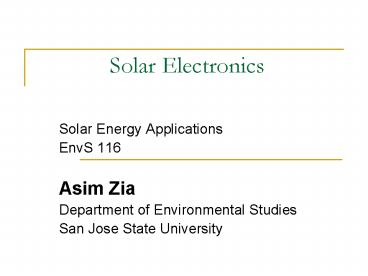Solar Electronics PowerPoint PPT Presentation
1 / 13
Title: Solar Electronics
1
Solar Electronics
- Solar Energy Applications
- EnvS 116
- Asim Zia
- Department of Environmental Studies
- San Jose State University
2
Overview
- PV efficiency estimates
- What is crystalline silicon on glass (CSG) thin
PV technology? - What is the background of crystalline silicon on
glass (CSG) thin PV technology? - CSG Device Structure
- CSG Manufacturing cost advantage
- Production cost and efficiency estimates
- Durability comparison of CSG with traditional
wafer-based modules - The future of Thin-film technologies
- Nano-PVs
- Organic PVs
3
PV efficiency (?) estimate
- ? Pm/IA
- Where ?Efficiency of a solar cell/panel/module
- Pm Maximum or peak power derived (in Watts)
- IInsolation or Irradiance measured in
Watts/Square Meter - A Area of the cell/panel/module
4
What is the background of crystalline silicon on
glass (CSG) thin PV technology?
- The crystalline silicon on glass (CSG) project
began in the late 1980s as a result of an
assessment of quite fundamental difficulties with
the traditional thin-films stability/complexity/c
ost trade-off, resource availability, and
toxicity, respectively (Green, 2003a). - The program gained critical momentum in 1995 with
the formation of Pacific Solar to bring the
technology to commercial readiness.
5
CSG background (Continued)
- Subsequent to demonstrating an independently
confirmed CSG module efficiency above 8 in 2002,
the program moved to a commercial scale-up stage
using 93cm x 78cm (0.7m2) glass substrates
(Basore, 2003, 2004). - In June 2004, a new company, CSG Solar, was
formed to take the technology into commercial
production, with modules expected to be
commercially available in 2006.
6
CSG Device Structure
7
CSG Manufacturing cost advantage
- One advantage of the CSG approach over the
nonsilicon thin-films, but shared with
wafer-based technology, is that it is able to
benefit from equipment development - This is particularly true for the silicon
deposition step where the CSG approach can use
equipment developed for depositing thin-film
transistors (TFTs) in active matrix liquid
crystal displays (AMLCD). - Generation 7 equipment, presently under
development, uses 5m2 sheets. A single Generation
7 machine could produce over 50MW/year of CSG
modules.
8
Proposed factory flow for 2025MW/year CSG module
production.
9
Manufacturing Cost Break-down for the 20-25
MW/year Factory
10
Production cost and efficiency estimates
11
Durability comparison of CSG with traditional
wafer-based modules
- Wafer-based modules generally degrade by 13
relative in output during the first few hours of
light exposure and then more gradually, about
0.30.6 per year relative over their operating
life. - Different mechanisms may be responsible for these
effects in different modules, but possible causes
are the degradation of the cell, its coatings
,solder joints or interconnects, or degradation
of the ethylene vinyl acetate (EVA) encapsulant
including its delamination, or even degradation
of the glass cover (Hishikawa, 2003). - As opposed to this well-documented experience, no
comparable degradation has been observed in CSG
modules subject to outdoor exposure.
12
Durability (continued)
13
The future of thin-film technologies
- Nano thin-film PVs
- Organic thin film PVs

